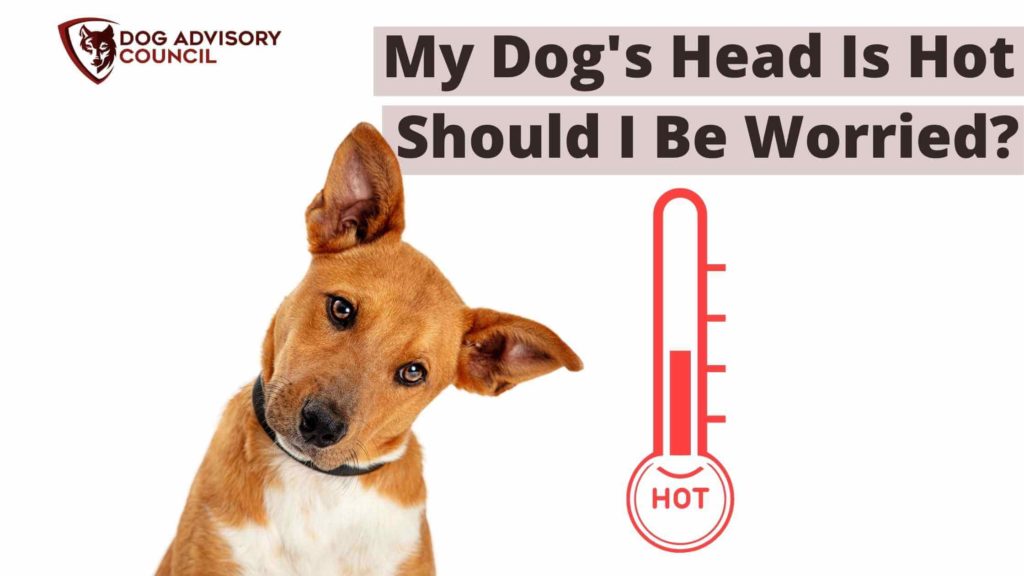
Is your dog’s head feeling hotter than usual? Are you worried that something is going on? Below is what you should use to help you understand what’s going on if your dogs head is hot!
If your dog’s head feels abnormally hot to your touch, they could have a fever. This can’t be confirmed through touch alone, however. Other popular reasons for your dog’s head to be hot include their natural cooling systems kicking in, dealing with high levels of excitement or stress, and having a reaction to their vaccinations. Rarely, it could be a sign of an underlying health concern.
Understanding the most likely culprit will help you get to the bottom of the issue and help your dog get back to their usual self!
Reasons why your dog’s head feel hot
It can often be alarming to us if we give our dogs a scratch and feel that their heads are hot. It seems so strange since they are acting otherwise normal. Right? A hot head is not immediately a reason for concern, though, as introduced above. Common reasons include:
- Your dog has a fever
- Your dog is cooling themselves
- Your dog is excited
- Your dog is stressed
- Your dog’s body is reacting to their vaccinations
- An underlying cause
Unlimited claims, No credit checks, No upper age limit & Multiple pet discounts
Compare the best rates on pet insurance
1. Your dog has a fever
This is the most common reason for humans, too, which is why it makes the most sense to us! A dog can have a hot head, which shows they are fighting a fever. This can’t be determined by touch alone (more on that later), but a hot head means their immune system is working hard. This is most often also paired with other symptoms of illness.
2. Your dog is cooling themselves
Dogs have their own built-in air conditioner. They can cool themselves through their blood. Part of the process will be sending the hot blood to their heads and ears, which will make them feel hot to the touch. They also will pant and drink cold water to help. This is normal after they have playtime!
3. Your dog is excited
Adorable and true. When your dog gets excited, their heart rate increases, which means that their temperature also rises. Depending on how excited they are, this can cause them to feel hot to the touch.
This excitement could be anything from a special treat to a walk, meeting a new dog, etc. It doesn’t take much for dogs to get excited, as we all know!
4. Your dog is stressed
On the flip side is the potential for your dog to be stressed out. For instance, if they hate the car, a car ride can make them anxious. Or the dreaded trip to the vet. Or even just something that makes them feel fear and worry.
A stressed dog’s heart rate will increase, the same as with excitement, and it will also be paired with other signs of stress. These can include hiding, whining, and shivering.
5. Your dog’s body is reacting to their vaccinations
This can be alarming at first, but remember that humans have this happen, too! When a dog gets a vaccine, their immune system works hard to adjust to this newly introduced combination of ingredients.
This makes a hard-working body and a touch of fever, resulting in a head that is hot to the touch. Also, as with humans, it’s a sign that the vaccination shots are working!
As the vaccine runs its intended course, it will fade away, and your dog will be back to normal! If not, bring your dog to the vet for a check-up.
6. There could be an underlying cause
In rare cases, a hot head can show something else going on. For example, it could be leukemia, a kidney problem, and more. Terrifying? Yes. Common? Thankfully, no.
A dog with a hot head is most often fine, especially if there are no other symptoms. If you notice your dog’s head is consistently hot from day to day and you’ve discarded the other options, there might be something serious brewing that needs a vet’s professional opinion.
If your dog’s health is failing, though, or you have reason to believe that something else is going on, check in with your vet just to be sure. For example, certain dog breeds are more susceptible to cancers and kidney problems.

Should my dog’s head feel hot?
First and foremost, what is “hot” to us and what is “hot” for our dog? Generally, it’s not as cut and dry as we think. Humans have sensitive fingers, sure, but they’re not always very accurate in how they detect things, either.
For instance, is your dog’s head actually hot, or is their fur just warm? Or, perhaps your fingers are abnormally cold. Understanding a dog’s head temperature will involve feeling around their snout and ears, too, to see how far the warmth spreads.
Switch hands, too, and use the inside of your wrist, the back of your hand, etc. If the temperature changes as you switch around, or as you change hands, etc., odds are that it’s just your fingers! If it stays mostly consistent, it is most likely your dog.
What to do if my dog’s head is hot?
If you’ve determined that your dog’s head is, indeed, hot, you’ll have a few steps that you can take to figure out what’s going on. These include:
- Check your dog’s temperature
- Assess your dog’s health otherwise
- Look at your dog’s environment
Checking your dog’s temperature will help you understand whether they are sick or not, of course. As for points 2 and 3, these focus on understanding what external factors could be impacting your dog’s temperature, as explained above.
The source is often easy to find when you do the process of elimination, and it will help you understand whether your dog needs a vet trip or not!
Can I check a dog’s temperature using its head?
Unlike when we use our hands or wrists to check our temperature or a family member, we can’t rely on this approach for dogs. Not only do dogs have fur in the way, but determining a fever through touch alone is not accurate since a hot head can show other things!
You’ll need to use a rectal thermometer to get an accurate temperature check for your dog. Your vet can help you with this if you need it! It can make many pet parents squeamish.
What is a normal temperature for a dog?
Dogs tend to hover around 99.5-102 degrees F (37.5-38.8 degrees C), which is considered normal and healthy! Puppies and seniors can differ, depending on other factors, but these numbers will give you a rough guide.
Anything above that range can be a fever. If your dog is within that normal range, though, they are fever-free, and something else is going on.
FAQ when dealing with a dog’s hot head
Here are some of the most common questions that pet parents ask when dealing with a dog’s head that feels hotter than usual!
My old dog’s head is hot: what does it mean?
Senior dogs are more sensitive to temperature than younger dogs are, so they’ll cycle through their cooling mechanisms more often than younger dogs. They are also more susceptible to sicknesses and other complications, so this makes a fever and reactions to vaccinations much more likely.
When it comes to senior dogs, it’s always best to check with your vet if you are worried about your dog’s temperature. If they do have a fever and/or are showing other worrisome signs such as lethargy or lack of appetite, a vet can take a look to see what’s going on.
What does it mean if my dog’s head is hot after a seizure?
When a dog has a seizure, it is always a cause for concern. Even if your dog has a pre-existing condition where these are common, a trip to the vet is something to consider seriously. If their head is hot after that seizure, it could be simply an aftereffect to calm the body down, similar to a stress response.
However, it can also be a sign of a complication from the seizure, such as head trauma. If their head stays hot, you’ll want to call your vet and see about bringing your dog in for a check-up. Most vets will recommend bringing your dog in after a seizure, anyway, just to be safe.
What does it mean if my dog’s head is hot and their nose is dry?
If you find that your dog’s head is hot and has a dry nose, this is a sure sign of a fever brewing. You’ll want to use a thermometer to confirm it, though. Anything above 103.5 degrees F (39.7 degrees C) is hot enough for you to bring your dog to the vet for a check-up! Especially if they have other symptoms such as lethargy, lack of appetite, shivering, and more.
Why are my dog’s head and ears hot?
Hot ears seem strange to us, but it’s normal for dogs. If their head and ears are hot at the same time, it’s likely a sign that they have put their cooling process to work, as explained above. If they’re panting and just got in from a walk, this is what’s happening.
While keeping an eye on it is always a good idea, it’s not something to be worried about in and of itself.
All in all
A dog’s head can feel hot to our touch for normal and abnormal reasons. The most common cause is that they have a fever. Other reasons include:
- Using their natural cooling mechanism on a hot day;
- Dealing with stress or excitement;
- Reacting to a vaccination;
- Signaling some sort of underlying health condition.
Understand the difference between normal and abnormal by knowing the other symptoms to watch for!
Discovering that your dog’s head is hot can be alarming for the attentive pet parent. Before you immediately jump in the car, however, use this guide to help you figure out what’s normal and what needs a vet’s attention!
Unlimited claims, No credit checks, No upper age limit & Multiple pet discounts
